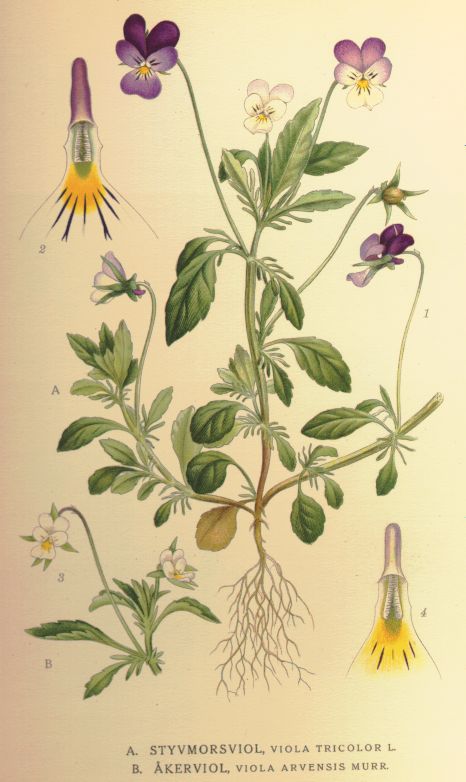- Viola tricolor
Taxobox
color = lightgreen
name = Heartsease
status =secure

image_width = 240px
regnum =Plant ae
divisio =Magnoliophyta
classis =Magnoliopsida
ordo =Malpighiales
familia =Violaceae
genus = "Viola"
species = "V. tricolor"
binomial = "Viola tricolor"
binomial_authority = L."Heartsease redirects here, for the place, seeHeartsease, Powys orHeartsease, Norwich "Heartsease ("Viola tricolor") is a common
Europe an wild flower, growing as an annual or short-lived perennial. It has been introduced intoNorth America , where it has spread widely, and is known as the Johnny Jump Up (though this name is also applied to similar species such as theYellow Pansy ). It is the progenitor of the cultivatedPansy , and is therefore sometimes called Wild Pansy; before the cultivated Pansies were developed, "Pansy" was an alternative name for the wild form.Heartsease is a small plant of creeping habit, reaching at most 15 cm in height, with flowers about 1.5 cm in diameter. It grows in short grassland on farms and wasteland, chiefly on acid or neutral soils. It is usually found in partial shade. It flowers from April to September. The flowers can be purple, blue, yellow or white. They arehermaphrodite and self-fertile, pollinated by bees.As its name implies, Heartsease has a long history of use in
herbalism . It has been recommended, among other uses, as a treatment forepilepsy ,asthma , skin diseases andeczema . It has expectorant properties, and so has been used in the treatment of chest complaints such asbronchitis andwhooping cough . It is also adiuretic , leading to its use in treatingrheumatism andcystitis .The flowers have also been used to make yellow, green and blue-green
dye s, while the leaves can be used to make a chemicalindicator .Long before cultivated pansies were developed, Heartsease was associated with thought in the "
language of flowers ", often by its alternative name of pansy (from the French "pensée" - thought): hence Ophelia's often quoted line in Shakespeare's "Hamlet ", "There's pansies, that's for thoughts". What Shakespeare had in mind was Heartsease, not a modern garden pansy.Shakespeare makes a more direct reference to Heartsease in "
A Midsummer Night's Dream ".Oberon sendsPuck to gather "a little western flower" that maidens call "Love-in-idleness". Oberon's account is that he diverted an arrow fromCupid 's bow aimed at "a fairvestal , throned by the west" (supposedlyQueen Elizabeth I ) to fall upon the plant "before milk-white, now purple with love's wound". The "imperial vot'ress" passes on "fancy-free", destined never to fall in love. The juice of the heartsease now, claims Oberon, "on sleeping eyelids laid, Will make or man or woman madly dote Upon the next live creature that it sees." Equipped with such powers, Oberon and Puck control the fates of various characters in the play to provide Shakespeare's essential dramatic and comic structure for the play.Heartsease has a large number of alternative colloquial names, up to two hundred.
Heartsease is also the title of a book in
The Changes trilogy, written byPeter Dickinson .References
External links
* [http://www.csdl.tamu.edu/FLORA/cgi/gallery_query?q=Viola+tricolor Links to images, collected by the Texas A&M University Bioinformatics Working Group]
* [http://www.pfaf.org/database/plants.php?Viola+tricolor Species information in the Plants for a Future database]
* [http://www.itis.gov/servlet/SingleRpt/SingleRpt?search_topic=TSN&search_value=22037 Integrated Taxonomic Information System: "Viola arvensis "]
* [http://plants.usda.gov/java/profile?symbol=VITR USDA, Natural Resources Conservation Service: Plants profile - "Viola tricolor" L. (johnny jumpup)]
Wikimedia Foundation. 2010.
